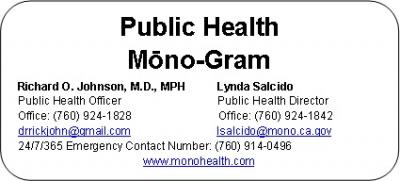Mono-Gram - Tragic Death Caused by Brain-Eating Ameba 7/01/2015
Tragic Death Caused by Brain-Eating Ameba
Family and friends are mourning the tragic death of a 21 year old Bishop resident who died recently from an extremely rare infection known as primary amebic meningoencephalitis (PAM). On June 16th, she woke up from a nap with headache, nausea, and vomiting. When these symptoms persisted into the next day, she went to the Emergency Department at Northern Inyo Hospital, where she was diagnosed with meningitis and admitted for treatment. Because her condition continued to deteriorate, she was flown to the Renown Regional Medical Center in Reno, Nevada, where she experienced a cardiac arrest in the Emergency Department, and died. Testing performed by the Centers for Disease Control and Prevention (CDC) in Atlanta was positive for evidence of the ameba known as Naegleria fowleri.
Public health staff has been diligently working with family, friends, and other stakeholders and partners to investigate the most likely source of her infection. We believe that the exposure occurred on private property that is only used by family and friends, and does not represent any risk to the general public. The investigation will continue, and all appropriate measures will be taken to involve and inform affected parties of any actions needing to be carried out to minimize any risk to persons in the future.
Humans become infected when water containing Naegleria fowleri enters the nose, usually while swimming or diving. People DO NOT get infected by DRINKING contaminated water. The ameba migrates to the brain along the olfactory nerve in the nose, through a bony plate in the skull called the cribiform plate, where it reaches the brain and begins to destroy brain tissue. The ameba has never been shown to have spread from one person to another.
Symptoms start quickly, usually within days of exposure and infection, and include: headache, fever, nausea, vomiting, and stiff neck. Later symptoms include: confusion, lack of attention, loss of balance, seizures, and hallucinations. After the start of symptoms, the disease progresses rapidly and usually causes death within 3-7 days.
This microscopic ameba is from a single cell class of organisms known as protozoa. They are common naturally occurring organisms that normally feed on bacteria and tend to live in the bottom layer of warm bodies of water. They thrive when temperatures are high and water levels are low. PAM infections have been reported worldwide. In the US, there have been 133 cases reported over the last 53 years (average of 3 per year), with only 3 survivors. Over half of cases were reported from Texas and Florida, with only seven cases from California. 75% of cases are associated with swimming in warm freshwater lakes and rivers. Other uncommon and unusual sources include:
- Geothermal water, such as hot springs/tubs
- canals
- slip-in-slide
- geothermal drinking water systems
- swimming pools that are poorly maintained and/or minimally chlorinated
- water heaters with temperatures less than 116 degrees F
- ritual nasal cleansing or irrigation using a neti pot
- religious practices
While the ameba is widespread, infections are rare because it is not a parasite that seeks out human hosts. Hundreds of millions of visits to swimming venues occur each year in the US that result in 0-8 infections per year. It is unknown why certain persons become infected with the ameba while millions of others exposed to warm recreational fresh waters, including those who were swimming with people who became infected, do not. The relative risk is extremely low, and yet the stakes are high because the chance of dying when infected is almost 100%.
How can you stay safe? As the CDC says, “The only certain way to prevent a Naegleria fowleri infection is to refrain from water-related activities in or with warm, untreated or poorly treated water”. I want to emphasize that there have been no evident cases of ameba contamination in the US in well-maintained, properly treated swimming pools or hot springs. Appropriate regular filtration and chlorination or other types of disinfectant should eliminate the risk.
Here are some tips:
- Keep your head above water in untreated hot springs or other thermally heated bodies of water, and during activities where water is forced up the nose, like water sports and diving.
- Hold your nose shut or wear nose clips when swimming in warm, untreated freshwater.
- Avoid digging in or stirring up sediment in shallow, warm freshwater areas, where the ameba may live.
- Avoid water-related activities in warm freshwater during periods of high temperature and low water levels.
- Avoid swimming in polluted water or unchlorinated swimming pools.
- If using a neti pot for nasal cleansing or irrigation, use only filtered or boiled water.
This is a tragic event for someone who becomes infected, as well as their family. I feel that it is important for all of us to be informed even though it does not affect lots of people each year. For more information, go to: http://www.cdc.gov/parasites/naegleria/index.html


